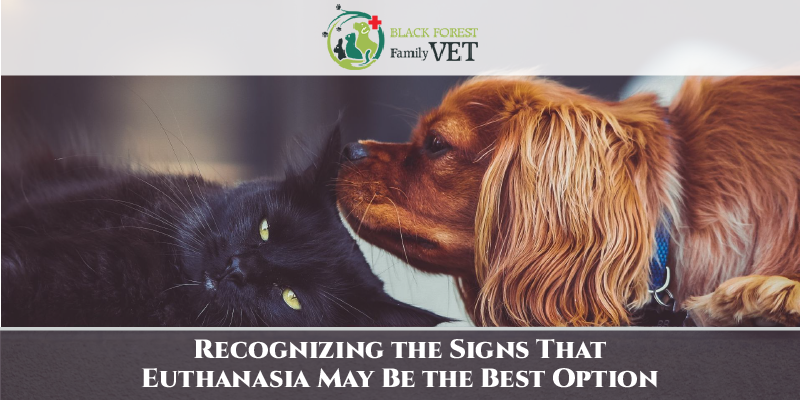Recognizing the Signs That Euthanasia May Be the Best Option

The decision to euthanize a pet is necessary, often a heart-wrenching choice. Understanding when to euthanize a pet is required, and knowing your pet’s pet’s end-of-life is nearby is essential. This disease is planned to ensure that an animal’s final moments are as peaceful or pain-free as possible. Euthanasia means “good death”; it involves when an animal’s quality of life is getting worse beyond recovery or when suffering from severe illness.
When your pet passes from this disease, you see various symptoms that say it’s time to say goodbye to your pet happily—signs of chronic pain or sudden weight loss, etc. Compared to normal death, euthanasia in one line, says the vet, is the best gift that is used at the appropriate time to prevent physical suffering.
Common Signs to Indicate Pet Euthanasia
As a pet owner, you should know the signs when to Euthanize a pet. Here are the common indicators:
Chronic Pain: When you notice your pet’s behavior and physical condition have changed, it can change simultaneously, such as aggression or irritability. They might suffer from complicated movement or show signs of stiffness; whining can also be a sign of pain. Feeling restless or visible signs like posture or weight loss can be a common sign of euthanasia.
Loss of Appetite: A complete loss of appetite in pets can indicate various underlying health problems, such as cancer, kidney failure, or liver issues. Pets do not eat appropriately cause they are not feeling well.
Difficult to Control Bowel: Incontinue bowel issues affect a pet’s life and may lead to severe health conditions. This problem occurs due to a lack of bladder control, which leads to sudden urination. It happens due to various digestive issues, one of which is euthanasia. These are the common Pet Euthanasia Indicators for accepting the goodbye situation for your furry friend.
Difficulty in Breathing: Difficulty in breathing or coughing can be a sign of severe respiratory issues.
Changes in Behaviour: If you seem to be excessively sleeping, you may have some behavioral changes; sudden aggression can be a sign of sudden discomfort.
Mobility: It is difficult to stand or move if your pet struggles to get up and falls repeatedly; it may be a sign that their physical condition is worsening.
Vomiting or Diarrhea: If your pet suffers constant vomiting or diarrhea that is not solved after treatment. Then, it may cause severe health problems.
Evaluating the Pet Quality
The most challenging factor is evaluating a pet’s Quality of Life. These are the key factors that will help you out:
- Behavioral Indicators: Observe the signs of discomfort or distress, like a behavior change. If your pet is experiencing pain, keep them happy, hydrated, and hygienic; interact with 5them to create an incredible bond and lead them toward positivity.
- Treatments: Evaluate whether the treatment effectively manages your pet’s pet’s condition. This includes mediation or therapies. If treatments are not working, consider your vet for a long-term prognosis. When the prognosis fails, euthanasia is a more efficient option.
- Emotional Distress: In this phase of the disease, they feel an emotional breakdown. That’s why pet owners should show affection and confidence toward their pets.
- Practical Care: It is required to manage the pet’s condition, and it must be determined that the pet needs excess care that is difficult to provide.
- Homely Environment: Consider whether your pet’s homely environment suits their comfort and well-being. Factors like easy access to food and water or maintaining hygiene play an essential role in their life.
- Veterinary Decision: The veterinarian plays a crucial role in deciding to euthanize. They provide professional treatment for your pet’s condition and discuss effective treatments and care.
The Decision to Euthanize a Pet
It is very tough to decide to euthanize a pet is a challenging decision. These are the factors to be considered:
- Consider your pet’s pet’s comfort, whether they experience more pain or distress to tolerate.
- Before making any tough decision, ensure that all treatments are explored with their effectiveness. If no therapy will improve their health, then euthanasia is the last choice.
- After all hope, euthanasia is the significant option for a happy death. Talk to your veterinarian about the next steps.
Conclusion
It is very tough and challenging to decide on pet Euthanasia, whereas if treatment does not work, then this is the efficient option. While it’s never easy to accept, ensuring that your pet’s pet’s final moments are peaceful is one kind of peace.
If you are facing a heartbreak condition and are confused, decide on euthanasia. Then, contact Black Forest Family Vet to discuss the available options by ensuring their final moments.